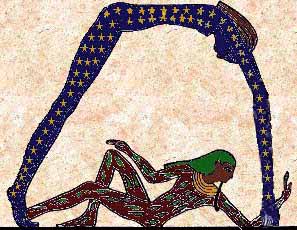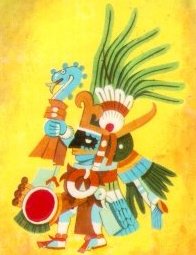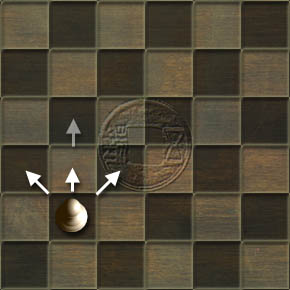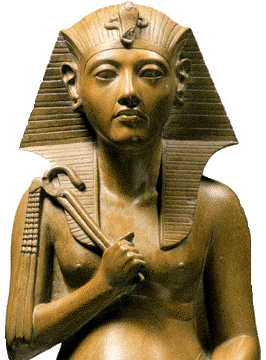|
11-29-01 - DREAM - I and my daughter were in New Berlin, WI, I think. This was not like reality. We were blue. We
were having a good time riding in vehicles and even riding backwards in wheelchairs for fun. I and my daughter
and our vehicles were blue, including our skin. We were laughing joyously while we were doing this.
But then we were in the house in the 2nd level room. I was standing, still facing west, and my daughter came in the porch door. She was coming towards me across the room. The floor was divided into squares. If she moved one square, everything was fine, but when she moved forward two squares, a blue man came through the door behind her without opening it. He had a sign on his chest that said, "NORTHWEST". I'm calling him the 'Boogie Man' because it seems like though he was tall like a man, he had an animal-like face, but he was all blue also. My daughter took a step forward one square and he didn't move, but when she stepped forward two squares, he also moved forward two squares right behind her. She moved forward one square towards me. He didn't move, she moved forward towards me two squares and he moved right with her. He was getting closer and closer to me. He couldn't get around her because there was a wooden counter next to her, he could only follow her, two squares by two squares. I had to wake up to stop her forward progress because I was afraid what would happen if she got too close to me.
|
|
NOTE: Northwest airlines has a blue beanie baby bear that stands. Bank of the West has a bear logo that is sometimes blue also. Basic Rules of Chess Chess is a elegantly simple yet amazingly complex game for two players. The game consists of an 8x8 board of alternating black and white squares. The pieces come as two identical sets, one white and one black. One person plays the black set of pieces and the other plays the white set. Play starts with white, after which the players take one turn each in succession. In Kung Fu Chess, however, players may move pieces at any time and need not wait for their opponent's next move. Instead, each piece has to 'recharge' once it has moved before it may be moved again. This makes the play much faster than traditional chess and lends the game some action elements. Play ends when one of the kings is taken by an opposing piece. The following is a description of how each chess piece may be moved:
The Pawn The Pawn is the weakest piece, but sometimes the most useful. It moves forward one square at a time, but it can not take another piece to do so. If an opposing piece is located one square diagonally forward and to the left or forward and to the right, the Pawn may take that piece by moving to its location. For the Pawn's initial move, it may move two squares forward instead of one. However, in doing so it may not jump over any other pieces in its way. The true power of the Pawn comes when it has advanced to the last row of squares on the board. At this time, it may be exchanged for any of the other pieces in the game! In Kung Fu Chess, it is automatically exchanged for a Queen. From: Basic Rules of Chess |
|
One Big Cheeseburger Grover the singing telegram deliverer
|
| From: Egypt Web Search | ||||||||||||||||||||||||||||||||
|

Nut - The goddess of the sky. She is generally depicted as a woman with blue skin, her body covered with stars, and standing on all fours leaning over husband (Geb) representing the sky over the earth
Geb - The god of the earth associated with the sacred animal and symbol, the goose. He is represented as a man with green or black skin.
During the day, Nut and Geb are separated, but each evening Nut comes down to meet Geb and this
causes darkness. If storms came during the day, it was believed that Nut had some how slipped
closer to the Earth.
Nut is the barrier separating the forces of chaos from the ordered cosmos in this world.
Her fingers and toes were believed to touch the four cardinal points or directions.
The sun god Re was said to enter her mouth after setting in the evening and travel through her
body during the night to be reborn from her vulva each morning.
She gives birth to the sun in the east and swallows the sun in the west.
Sometimes she appears in the form of a cow whose body forms the sky and heavens. Nut in this form
represents the Great Kau (Cow), the Great Lady who created all that exists, the Cow whose udder
gave forth the Milky Way. (Also represented as the cow goddess Hathor.) Nut was considered to be
the mother of the sun and the moon. In the form of a great cow her eyes represent the sun and the
moon.
From: Alex Collier and the Andromedans
I have been a contactee for 31 years. It has not been consistent for 31 years, but it has been consistent since 1985. The first contact was in the upper peninsula of Michigan in a place called Woodstock. In 1964 I was on a family picnic. I went out to play with cousins, and I laid on the grass. The next thing I remember is that it was night time. They could not find me. I had missing time. I did not remember anything until age 14. We went back to the area where I had been sleeping. My body print was there. My mom, dad and a Michigan State Trooper swore up and down that they had looked for me. I wasn’t there. So, it was one of those dilemma’s. At age 14, I went to bed on a normal August night. I woke up and found myself on a platform. There were two men standing over me, a short one and a very tall one. They were both very handsome. On a soul-level, I had absolute recognition of who they were. The tall one, Moraney, had light blue skin. Vasais, the shorter one, was much older, and his skin was whitish, having lost most of the blue pigmentation.
The Andromedans are a very very old race. Apparently, all of the human race comes from Lyrae. There is a lot of information about this. Billy Meier also talks about it. The human race did not originally exist in Lyrae - it came from some other galaxy but first began to evolve in our galaxy in the Lyran system. According to the Andromedans, there are over 135 billion human beings in the 8 galaxies closest to ours. Now, there are also other races out there. Some of these races have had a lot of conflicts with the human race, and that conflict continues. But, there are things that are happening that will hopefully alleviate that problem. It comes down to philosophies, more than anything else.
The Andromedans are a telepathic race. Moraney, over the last ten years, has learned to use his vocal chords. The reason that the newsletter here is called Letters From Andromeda, is because the first words that Moraney said to me when I went on board one time were “another letter”. He was trying to convey the idea of “meeting”, and had been trying to search for the word. The Andromedans care really deeply about what is going on, and a lot of it apparently has to do with who we are as souls, who we are genetically, and it also has to do with the future - a future in which we will probably be in other physical forms. We’re talking about the future between now and 357 years from now.
From: http://www.koausa.org/Gods/God3.html

Lord Vishnu represents the aspect of the Supreme Reality that preserves and sustains the universe. Although there are variations in images and pictures of Lord Vishnu, He is generally symbolized by a human body with four arms. In His hands He carries a conch (shankha), a mace (gada), and discus (chakra). He wears a crown, two earrings, a garland (mala) of flowers, and a gem around the neck. He has a blue body and wears yellow clothes. The Lord is shown standing on a thousand-headed snake (named Shesha Nag), and the snake stands with its hoods open over the head of the Lord.
The four arms indicate Lord's omnipresence and omnipotence. The two front arms signify the lord's activity in the physical world and the two back arms signify His activity in the spiritual world. The right side of the body represents the creative activities of the mind and the intellect. The left side symbolizes the activities of the heart; that is, love, kindness, and compassion.
A conch in the upper left hand indicates that the Lord communicates with His devotees with love and understanding. When blowing His conch, He reminds his devotes to live in this world with kindness and compassion towards all living beings. A chakra in His upper right hand conveys the idea that the Lord uses this weapon to protect His devotees from evil. The mace denotes energy and a mace in the Lord's left lower hand signifies that He sustains the manifest world by the energy that He holds in Himself. His front right hand is depicted bestowing grace on His devotees.
The snake denotes the mind and the thousand heads of the snake signify innumerable desires and passions of an individual. Just as a snake destroys its victim by its venom, an uncontrolled mind destroys the world by the venom of its possessiveness. The Lord has controlled all desires, and this is symbolized by showing Him seated on the two coils of the snake. When a sincere devotee of the Lord controls his desires, the Lord fulfills the devotee's genuine desires and helps him on his path.
The blue sky in the background of the Lord suggests that He pervades the entire universe. The blue color symbolizes infinity. The blue body of the Lord signifies that He has infinite attributes. He is nameless, formless, and immeasurable. The color yellow is associated with earthly existence and the yellow clothes of the Lord signify that He incarnates Himself on this earth to uphold righteousness and destroy evil and unrighteousness.
A flower garland around the Lord's neck is a symbol of the devotee's adoration for the Lord. A gem decorating His neck signifies that the Lord fulfills all genuine desires of His devotees and provides for their needs. The crown is a symbol of the Lord's supreme power and authority. The two earrings signify the dual nature of creation, such as knowledge and ignorance, happiness and unhappiness, and pleasure and pain.
The worship of Lord Vishnu is very popular among Hindus, especially among the followers of the Vaishnava tradition (Vaishnavism). He is the second member of the Hindu Trinity, with Lord Brahma and Lord Shiva as the other two. Lord Vishnu is also known by other names, such as Vasudeva and Narayana. The following ten incarnations of Lord Vishnu are described in Hindu mythology and are popular among Hindus. These incarnations reveal the help rendered by God during various stages of human evolution. As shown below, the first two incarnations are in the animal form, the third one is half-human and half-animal, and the fourth and the subsequent ones are all in human form. These incarnations relate to human evolution from aquatic life to human life, and are consistent with the modern theory of evolution suggested by science:
-
Matsya (fish)---saves Sage Manu from floods and recovers the Vedas from demons. The first incarnation, the fish-man. The ancient ancestor of the whole of humanity, Manu, was told to construct a large boat to save all living creatures from a great flood. The giant fish saved the boat, which contained a pair of every living creature, by pulling it to safety. Matsya also managed to save The Vedas from the demon Hayagriva. Matsya has four arms and carries the sacred objects of Vishnu, the wheel, a conch shell, a club and a lotus flower.
-
Kurma (tortoise)---sustains the earth on his back. The second incarnation, the tortoise man. The Gods and the demons were entangled in a lengthy war which imperiled the moral order of the universe as the power of the demons became stronger and stronger. The Gods attempted to churn the ocean of milk to extract the nectar of immortality which would make them invincible. The Gods used a mountain to churn the milk and this failed to retrieve the nectar so Vishnu in the form of giant tortoise acted as a support for the mountain and the Gods were successful. Kurma has four arms and carries the wheel, a lotus flower, a conch shell and a club.
-
Varaha (boar)---brings the earth back from the bottom of the ocean where it was dragged down by a demon, known as Hiranyaksha; Varaha kills the demon. The third incarnation of Vishnu who isdepicted as a man with the head of a boar or simply as the animal itself. One of the myths of the flood tells of a demon who abducted the Goddess of the earth, Prithivi, and hid at the bottom of the primordial ocean. Vishnu assumed the form of a boar and dived into the ocean and defeated the demon rescuing the earth Goddess in his tusks. Varaha helped the Goddess to restore back to the earth its life sustaining potential by carving mountains and creating the continents. This incarnation of Vishnu can have two or four sets of arms and is equiped with all of the scared objects.
-
Narasimha (man-lion)---kills the demon King Hiranyakashipu, who was planning to kill his own son, a devotee of Lord Vishnu. The fourth incarnation of Vishnu,he is half-man and half-lion. A servant of Vishnu had enraged the God who had condemned the man to live the rest of his existence as a demon. However he was granted a special blessing which meant that he could not be killed by any weapon used by either man or animal, by day or night, or inside or outside. The lives of the Gods were made difficult by his very existence and Vishnu once again intervenes. Narasimha (neither animal or man), hid in a pillar at the entrance to the demon's house, and attacked the demon at dusk (neither day or night) on the threshold of the house (neither inside or outside) and killed him with his claws( without weapons).
-
Vamana (dwarf)---the first human incarnation of the Lord, kills the demon King Mahabhali, who had deprived the gods of their possessions. The fifth incarnation of Vishnu and the first to have a completely human form although it is that of a dwarf. A demon King managed to overthrow the Gods and conquered the three worlds. Vishnu assumed the form of a dwarf and approached the demon king and requested a place for meditation which would encompass three paces. The king agreed and immediately Vishnu assumed the form of a giant who took three paces which encircled heaven, the earth and the underworld. Vamana is usually depicted with two arms and he carries a par asol, a water jug, a book and he has long hair in a topknot and he wears a loincloth or animal skin.
-
Parasurama (the warrior with an axe)---saves Brahmins from the tyranny of the arrogant Kshatriyas. The sixth incarnation of Vishnu, Rama with an axe who appears in human form. A terrible war raged between the priestly and warrior castes and Parashurama intervened to finally win a victory after twenty -one battles. Parashurama is depicted as a young priest with his hair tied in a topknot like a holy man and he carries an axe, a bow and a sword.
-
Rama---kills Ravana, the demon king of Lanka. The seventh incarnation of Vishnu also known as Ramachandra. He is depicted as a young king carrying a bow and arrow and is frequently accompanied by his wife Sita, an incarnation of Lakshmi. Rama is the hero of the Ramayana who destroys the demon king Ravana and restores the moral order of the universe. The figures of Rama and Sita embody the very idea of Dharma itself and symbolise honesty, loyalty and the ability to perform their duty.
-
Sri Krishna---the most popular incarnation; Krishna's contributions throughout his life include the teachings of the Bhagavad Gita to Arjuna. The eighth incarnation of Vishnu who is considered by many to be the most important and is worshipped as a God in his own right. The life and the deeds of Krishna are retold in the Bhagavata Purana and he is the hero in the Mahabharata. Krishna is depicted in the Puranas as a pastoral God who periodically performs acts of superhuman ingenuity which confirm his divine origins. In the Mahabharata Krishna reveals his divinity to Arjuna and shows his true form as the source of all that is.The skin of Krishna is usually black or blue, black due to his origins from a strand of hair from the head of Vishnu. The skin of Krishna is blue since he symbolises infinity itself which like the sky encompasses all and everything pervading our whole existence, hence the significance of Krishna's blue skin. Krishna is most frequently depicted as a pastoral God playing a flute or as Arjuna's charioteer on the battlefield of Kurukshetra. He is also depicted with Radha his female consort who symbolises the perfect devotee by demonstrating her love for Lord Krishna. He is also depicted as a dancer dancing on the many heads of the snake Kaliya after defeating him and is also shown dancing (lila rasa or divine play) with the cowsmaids or Gopis and from his association with them he is known as Govinda/Gopala. A name derived fom a roo A way into this subject may be through music such as the Kula Shaker song "Govinda" track four on the "K" album. The Christopher Pike book, "The Last Vampyre" has an excellent passage describing Krishna and his relationship to Radha.
-
Buddha---Hindus consider Buddha as an incarnation of Lord Vishnu and accept his teachings, but do not directly worship him. He is seen as the ninth incarnation of Vishnu who descended to earth to purify Hinduism from the priestly rituals which seemed to dominate it entirely. The new doctrine which he taught was based on deliverance from the wheel of rebirth by means of correct conduct and inner attitude. The Buddha is depicted seated on a lotus in simple garments without any ornaments.
-
Kalkin (a man on a white horse)---this incarnation is yet to come and will mark the end of all evil in the world. The last incarnation which has not appeared on earth. At the end of the present age humanity will be obscured in darkness and moral values will disappear. Vishnu will return in the form of Kalki who will restore dharma and will begin a new era of purity and peace. This incarnation is usually depicted as Vishnu riding a white horse carrying his usual sacred objects with a sword instead of a club. kalki can be depicted as a God with the head of a horse and four arms
From: http://www.spiritweb.org/Spirit/etheric-planets.html
The first race was the Etheric or Borean Root-Race, which wasn't entirely physical, being of the higher physical etheric density, and wasn't even remotely like the humanity of today. Second was the Hyperborean Root-Race, all traces of which, along with the first race, have long since vanished. Third was the Lemurian Root-Race. This was a civilization characterized by activity, and development of individual free will. This was the mythical Garden of Eden which humanity "fell" from. Lemurians were over 12 feet tall, and the first race to develop separate genders. The Lemurian continent was in the Pacific Ocean, with today's Easter Island a remnant of it. Fourth was the Atlantian Root-Race, existing from roughly a million to 10,000 years ago, again different from humanity of today, with many Atlantians having blue skin. This civilization was characterized by emotion, and as a result certain periods in Atlantis were very peaceful and spiritual, while others were filled with strife and occult conflict not unlike Dungeons and Dragons, proceeding until the breakup and sinking of the Atlantian continent.
THE BLUE MAN OF INDIA -
PAPER 79: Section 2.
The Andite Conquest Of India
The earliest race mixtures in India were a blending of the
migrating red and yellow races with the aboriginal Andonites. This group was
later weakened by absorbing the greater portion of the extinct eastern green
peoples as well as large numbers of the orange race, was slightly improved
through limited admixture with the blue man but suffered exceedingly through assimilation of large numbers of the
indigo race. But the so-called aborigines of India are hardly representative of
these early people; they are rather the most inferior southern and eastern
fringe, which was never fully absorbed by either the early Andites or their
later appearing Aryan cousins.
By 20,000 B.C. the population of western India had already become tinged with the Adamic blood, and never in the history of Urantia did any one people combine so many different races. But it was unfortunate that the secondary Sangik strains predominated, and it was a real calamity that both the blue and the red man were so largely missing from this racial melting pot of long ago; more of the primary Sangik strains would have contributed very much toward the enhancement of what might have been an even greater civilization. As it developed, the red man was destroying himself in the Americas, the blue man was disporting himself in Europe, and the early descendants of Adam (and most of the later ones) exhibited little desire to admix with the darker colored peoples, whether in India, Africa, or elsewhere.
About 15,000 B.C. increasing population pressure throughout Turkestan and Iran occasioned the first really extensive Andite movement toward India. For over fifteen centuries these superior peoples poured in through the highlands of Baluchistan, spreading out over the valleys of the Indus and Ganges and slowly moving southward into the Deccan. This Andite pressure from the northwest drove many of the southern and eastern inferiors into Burma and southern China but not sufficiently to save the invaders from racial obliteration.
The failure of India to achieve the hegemony of Eurasia was largely
a matter of topography; population pressure from the north only crowded the
majority of the people southward into the decreasing territory of the Deccan,
surrounded on all sides by the sea. Had there been adjacent lands for
emigration, then would the inferiors have been crowded out in all directions,
and the superior stocks would have achieved a higher civilization.
As it was, these earlier Andite conquerors made a desperate attempt
to preserve their identity and stem the tide of racial engulfment by the
establishment of rigid restrictions regarding intermarriage. Nonetheless, the
Andites had become submerged by 10,000 B.C., but the
whole mass of the people had been markedly improved by this absorption.
>Race mixture is always advantageous in that it favors versatility of culture and makes for a progressive civilization, but if the inferior elements of racial stocks predominate, such achievements will be short-lived. A polyglot culture can be preserved only if the superior stocks reproduce themselves in a safe margin over the inferior. Unrestrained multiplication of inferiors, with decreasing reproduction of superiors, is unfailingly suicidal of cultural civilization.
Had the Andite conquerors been in numbers three times what they
were, or had they driven out or destroyed the least desirable third of the mixed
orange-green-indigo inhabitants, then would India
have become one of the world's leading centers of cultural civilization and
undoubtedly would have attracted more of the later waves of Mesopotamians that
flowed into Turkestan and thence northward to Europe.
THE DISPERSION OF THE COLORED RACES
The Aztec god, Huitzilopochtli

Huitzilopochtli
was the Aztec god of the sun and war. His name means Blue Hummingbird on the
Left. He is often pictured as a blue man with hummingbird feathers on his head.
His brother and sisters were the stars. The moon is another sister.
Pegasians |
Member Name: Pegasus Star League. |
From: The Illinois Files
In 1841 an unknown man was found hanging in Clement's Cemetery east of
Champaign. Whether he was the victim of a lynching or a suicide is unknown. The
people removed his body and gave him a proper burial. Soon after reports came
back of the "Blue Man," a thin wispy ghost of blue that can only be
seen in the light of the full moon.
THE BLUE PEOPLE OF KENTUCKY
Fugate Family: Blue People of Kentucky
http://wsrv.clas.virginia.edu/~rjh9u/blueky.html
http://www.people.virginia.edu/~rjh9u/blkysc82.html
http://kanawha.lib.wv.us/ref/rolodex/ro-blue.htm
http://www.straightdope.com/classics/a980724.html
FROM: THE MAGONIA DATABASE
Jan. 28, 1967 Studham (Great Britain). Children observed "a little
blue man with a tall hat and a beard" that disappeared in a puff of smoke;
they later saw him again, and heard "foreign-sounding" voices. (FSR
67, 4; Ma- gonia)
DREAMS OF THE GREAT EARTHCHANGES
MAIN INDEX


 Most
Egyptologists assign Amenhotep I a reign of 25 or fewer years.
However, it should be mentioned that on a number of his
monuments at the Temple of Karnak are found various
Most
Egyptologists assign Amenhotep I a reign of 25 or fewer years.
However, it should be mentioned that on a number of his
monuments at the Temple of Karnak are found various 